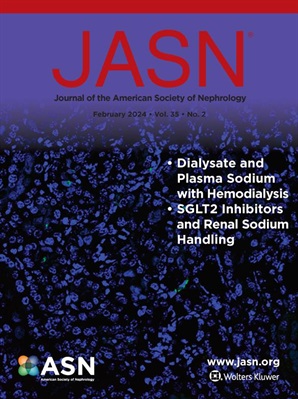Biomarkers of Kidney Failure and All-Cause Mortality in CKD.
IF 10.3
1区 医学
Q1 UROLOGY & NEPHROLOGY
引用次数: 0
Abstract
BACKGROUND Chronic kidney disease (CKD) carries a variable risk for multiple adverse outcomes, highlighting the need for a personalised approach. This study evaluated several novel biomarkers linked to key disease mechanisms to predict the risk of kidney failure (first event of eGFR <15 ml/min/1.73m2 or kidney replacement therapy), all-cause mortality, and a composite of both. METHODS We included 2,884 adults with non-dialysis CKD from 16 nephrology centres across the UK. Twenty-one biomarkers associated with kidney damage, fibrosis, inflammation, and cardiovascular disease were analysed in urine, plasma, or serum. Cox proportional hazards models were used to assess biomarker associations and develop risk prediction models. RESULTS Participants had mean age 63 (15) years, 58% were male and 87% White. Median eGFR 35 (25, 47) ml/min/1.73m2, and median urinary albumin-to-creatinine ratio (UACR) 197 (32, 895) mg/g. During median 48 (33, 55) months follow-up, 680 kidney failure events and 414 all-cause mortality events occurred. For kidney failure, a model combining three biomarkers (sTNFR1, sCD40, UCOL1A1) showed good discrimination (c-index 0.86, 95% CI: 0.83-0.89) but was outperformed by a model using established risk factors (age, sex, ethnicity, eGFR, UACR; c-index 0.90, 95% CI: 0.88-0.92). For all-cause mortality, a model using three biomarkers (hs-cTnT, NT-proBNP, suPAR) demonstrated equivalent discrimination (c-index 0.80, 95% CI: 0.75-0.84) to an established risk factor model (c-index 0.80, 95% CI: 0.76-0.84).For the composite outcome, the biomarker model discrimination (C-index 0.78, 95% CI: 0.76, 0.81) was numerically higher than for established risk factors (C-index 0.77, 95% CI: 0.74, 0.80), and the addition of biomarkers to the established risk factors led to a small but statistically significant improvement in discrimination (C-index 0.80, 95% CI: 0.77, 0.82; p value < 0.01). CONCLUSIONS Risk prediction models incorporating novel biomarkers showed comparable discrimination to established risk factors for kidney failure and all-cause mortality.CKD中肾衰竭和全因死亡率的生物标志物。
背景:慢性肾脏疾病(CKD)具有多种不良后果的可变风险,强调了个性化治疗的必要性。本研究评估了几种与关键疾病机制相关的新型生物标志物,以预测肾衰竭的风险(eGFR <15 ml/min/1.73m2或肾脏替代治疗的首次事件)、全因死亡率,以及两者的组合。方法:我们纳入了来自英国16个肾脏学中心的2,884名非透析性慢性肾病成人患者。在尿液、血浆或血清中分析了与肾损害、纤维化、炎症和心血管疾病相关的21种生物标志物。Cox比例风险模型用于评估生物标志物相关性并建立风险预测模型。结果参与者平均年龄63(15)岁,58%为男性,87%为白人。中位eGFR为35 (25,47)ml/min/1.73m2,中位尿白蛋白与肌酐比值(UACR)为197 (32,895)mg/g。在中位48(33,55)个月的随访期间,发生了680例肾衰竭事件和414例全因死亡事件。对于肾衰竭,联合三种生物标志物(sTNFR1, sCD40, UCOL1A1)的模型显示出良好的辨别能力(c指数0.86,95% CI: 0.83-0.89),但优于使用既定危险因素(年龄,性别,种族,eGFR, UACR;c-index 0.90, 95% CI: 0.88-0.92)。对于全因死亡率,使用三种生物标志物(hs-cTnT, NT-proBNP, suPAR)的模型与已建立的危险因素模型(c-index 0.80, 95% CI: 0.76-0.84)显示出相同的区别(c-index 0.80, 95% CI: 0.76-0.84)。对于复合结果,生物标志物模型的辨别性(C-index 0.78, 95% CI: 0.76, 0.81)在数值上高于已确定的危险因素(C-index 0.77, 95% CI: 0.74, 0.80),并且在已确定的危险因素中添加生物标志物导致了辨别性的小幅但具有统计学意义的改善(C-index 0.80, 95% CI: 0.77, 0.82;P值< 0.01)。结论纳入新型生物标志物的风险预测模型在肾衰竭和全因死亡率方面与已建立的危险因素具有可比性。
本文章由计算机程序翻译,如有差异,请以英文原文为准。
求助全文
约1分钟内获得全文
求助全文
来源期刊
CiteScore
22.40
自引率
2.90%
发文量
492
审稿时长
3-8 weeks
期刊介绍:
The Journal of the American Society of Nephrology (JASN) stands as the preeminent kidney journal globally, offering an exceptional synthesis of cutting-edge basic research, clinical epidemiology, meta-analysis, and relevant editorial content. Representing a comprehensive resource, JASN encompasses clinical research, editorials distilling key findings, perspectives, and timely reviews.
Editorials are skillfully crafted to elucidate the essential insights of the parent article, while JASN actively encourages the submission of Letters to the Editor discussing recently published articles. The reviews featured in JASN are consistently erudite and comprehensive, providing thorough coverage of respective fields. Since its inception in July 1990, JASN has been a monthly publication.
JASN publishes original research reports and editorial content across a spectrum of basic and clinical science relevant to the broad discipline of nephrology. Topics covered include renal cell biology, developmental biology of the kidney, genetics of kidney disease, cell and transport physiology, hemodynamics and vascular regulation, mechanisms of blood pressure regulation, renal immunology, kidney pathology, pathophysiology of kidney diseases, nephrolithiasis, clinical nephrology (including dialysis and transplantation), and hypertension. Furthermore, articles addressing healthcare policy and care delivery issues relevant to nephrology are warmly welcomed.

 求助内容:
求助内容: 应助结果提醒方式:
应助结果提醒方式:


